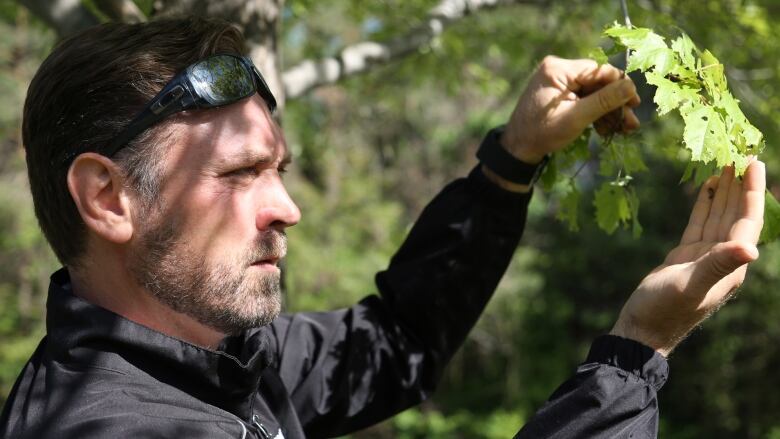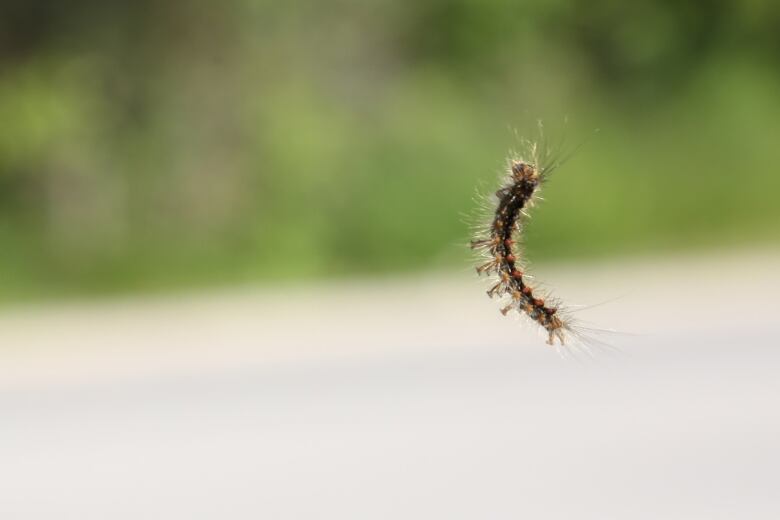Cankerworms and Gypsy moths wreaking havoc on Hamilton trees
'This is the worst I've ever seen of cankerworm,' says senior arborist Chris Deathe

If you stand beneath the canopy of a large oak or walnut treeand listen closely, you may hear thesoft sound of caterpillar poop bouncing off leaves and landing on your shoulders.
"It sounds like it's raining," says Chris Deathe, a senior arborist with Davey Tree.
This is the time of year when both gypsy moth and cankerworm caterpillars are active, eating tree leavesand preparing to hide themselves away to transition into their adult stage of life. And this year,they're particularly bad, especially in the western parts of the city.
Evidence of these caterpillars is easy to spot.. Look for trees carrying leaves that resembleSwiss cheese, or branches that are completely bare.But watch your step when walking around them; these caterpillars are often dangling from lines of silk, dancing in the wind, slowly making their way towards the ground.

Protecting the trees
"This is the worst I've ever seen of cankerworm," saidDeathe, who's been working as an arborist for the last 23 years. There is a corridor of conservation land that stretches along the escarpment and down towards the west end of Burlington that has been hit hard by cankerworm, he said. The caterpillar tends to favour oaks, walnuts, birch and soft maple trees.
Gypsy moths have been bad this year too, he said, adding their population tends to rise and fall incycles over a series of years.
The cankerworm has a one-year life cycle. As larvae, thespecies will eat their fill ofyoung leaves beforedropping to the groundto spin cocoons and pupate,Deathe said. As they transition to adulthood, the males will emerge as winged moths, but the females will be wingless.
Adultcankerworms will emerge from the soil at two different times of the year, he said.Spring cankerworms will emerge in the spring and fall cankerworms will emerge in the fall.
There are various techniques to protect a tree against this caterpillar, Deathe said,including spraying with natural or synthetic insecticide or wrapping a sticky band around the trunk of the tree. Because the female has to climb up the tree in order to mate, thesticky band will stop the female in her tracks.
However, these bands will only work whena tree is fairly isolated, away from the reach of other tree branches, Deathe said.If the female can climb up other trees, she may be able to move from one tree to the next on the wind.
LeAnn Seely, forestry and horticulture manager with the City of Hamilton, said the city recommends residents next to forested areasband their trees.

Infestation, not outbreak
She described the city as having an infestation of cankerworm, but hesitated incalling it an outbreak. An outbreak would mean the species has spread throughout the city, she said. This particularinfestation can be found inDundas and Ancaster, spreadingdown the 403 and through the Dundas valley. "It's not city-wide."
In 2008, the city was sprayed with an insecticide to keep the caterpillarpopulations down, Seely said. This was the last time the city was sprayed.
Due to the largepopulations ofcankerwormthis year, Seely said city plans on hiring a professional to monitor the number of egg pouches found in trees this fall. This will help determine how to deal with this infestation.
Trees are resilient and can tolerate the cankerworm of gypsy moth eating away the leaves, Seely said. The tree will grow new leaves in a few weeks, after the caterpillars' feeding stage has passed.However, a tree can't handle losing allits leaves to caterpillarsevery year, she said.
"The tree gets exhausted, basically, and goes into poor health," she said. Trees in an urban environment are already stressed and need special attention. Trees on city streets or parks aren't as resilient as trees growing in a forest, she added.
When trees grow a new set of leaves after the caterpillar feeding season is over, they'llneed a lot of water and possibly deep-root fertilizer or natural mulching around their base, Deathe said. This will keep them healthy and able to bounce back from the infestation.
Residents concerned about their trees should contact a certified arborist to get advice on how best to care for their tree, he said.












_(720p).jpg)


 OFFICIAL HD MUSIC VIDEO.jpg)
.jpg)



























































































